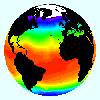 |
|
|
|
|
|
|
All models must simplify what is a very complex climate
system. This is in part due to the limited understanding that exists of
the climate system, and partly the result of computational restraints.
Simplification may be achieved in terms of spatial dimensionality, space
and time resolution, or through parameterisation of the processes that
are simulated. |
General
circulation models (GCMs) represent the most sophisticated attempt
to simulate the climate system. The 3-D model formulation is based on
the fundamental laws of physics (conservation of energy, conservation
of momentum, conservation of mass, and the Ideal Gas Law). To compute
the basic atmospheric variables at each gridpoint requires the storage,
retrieval, recalculation and re-storage of 105 figures at every
time-step. Since the models contain thousands of grid points, GCMs are
computationally expensive. However, being 3-D, they can provide a reasonably
accurate representation of the planetary climate, and unlike simpler models,
can simulate global and continental scale processes (e.g. the effects
of mountain ranges on atmospheric circulation) in detail. The spatial
resolution of GCMs, however, is limited in the vertical dimension. Figure
1 shows that different GCMs do not exactly show the same results e.g concerning
humidity. Therefore, it is crucial to compare distinct models and their
results in order to improve them. (Joussaume and Taylor, 1998) |
1- Comparison of GCM models |
| Through much of the history
of climate modelling, division between modelling and observational
studies has hampered the development of both sides. The coupling of
these theoretical and empirical disciplines, to test both model accuracy
and understanding gained from analysis of observational data, has
only recently been addressed. Such a divide must be bridged if accurate
forecasts of future climates are to be produced. |
| |
|
Global
Climate Change Guide Lamont-Doherty Earth Observatory of Columbia University Climate and Global Dynamics (CGD) Division of the National Center for Atmospheric Research |
|||
29 August 2011 |
||
| |
||
 Climate
models attempt to simulate the behaviour of the climate system. Through
understanding the climate system, it is possible to obtain
Climate
models attempt to simulate the behaviour of the climate system. Through
understanding the climate system, it is possible to obtain